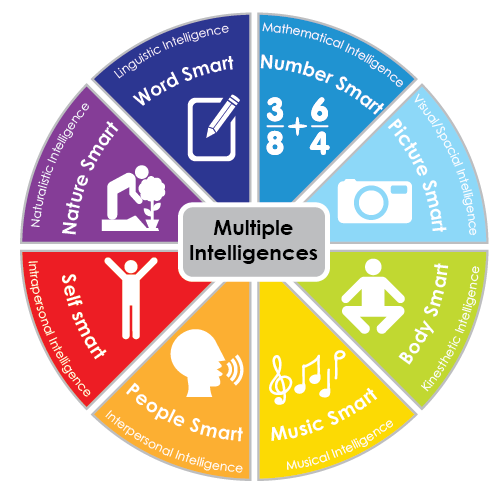4 Evaluate Your Learning Skills and Strengths
Even if the university environment is new to you, you already come to learning with a set of skills, strengths, and strategies that can contribute to your success. Before you move on in this chapter, take some time to reflect on the following questions. You may wish to write your answers on this page, or in another learning journal.
1. Consider a learning experience in the past that was successful for you. What were you able to learn?
2. What did you do that helped you to succeed in your learning?

Often, we associate learning in university with strengths in reading and writing. Though it is true that reading and writing are important skills used in many courses, you can also apply other learning strengths to contribute to successful learning.
One framework for evaluating your personal strengths is Multiple Intelligences, based on research by Howard Gardner. Gardner proposed that there are eight different ways of learning, creating things, and solving problems. Everyone uses all eight of these intelligences; however, in each individual, some intelligences are areas of strength, while others are weaker. This accounts for our different preferences in learning.
|
Intelligence |
Description |
| “Word smart” – Linguistic Intelligence | The capacity to use language to express what’s on your mind and to understand other people. People who are high in this intelligence are sensitive to language, meanings, and the relationship of words. They engage easily with vocabulary activities, grammar, poetry, essays and plays. |
| “Number smart” – Mathematical Intelligence | People with a highly developed logical-mathematical intelligence understand the underlying principles of some kind of a causal system; or can manipulate numbers, quantities, and operations. Abstract thinking, counting, organizing; and logical structures are preferred by people high in this intelligence. They also like critical thinking activities, breaking words into smaller parts and reassembling them. |
| “Picture smart” – Visual/spatial Intelligence | The ability to represent the spatial world internally in your mind. Spatial intelligence can be used in the arts or in the trades and sciences. If you are spatially intelligent and oriented toward the arts, you are more likely to become a painter or a sculptor or an architect than, say, a musician or a writer. These people tend to be keen observers, able to think in three dimensions, and like to use metaphors. Learning materials that work well for them include: graphs, charts, colour codes, guided imagery, pictures, posters, and mind maps. |
| “Body smart” – Kinesthetic Intelligence | The capacity to use your whole body or parts of your body – your hand, your fingers, your arms – to solve a problem, make something, or put on some kind of a production. These people have good body control and fine motor skills; and are often active and animated. They need “hands-on” learning opportunities, like shop, labs, games, skits, and plays. |
| “Music smart” – Musical Intelligence | The capacity to think in music, to be able to hear patterns, recognize them, remember them, and perhaps manipulate them. People who have a strong musical intelligence don’t just remember music easily – they can’t get it out of their minds, it’s so omnipresent. People will be sensitive to rhythm, pitch, intonation, and can remember tunes and rhythms easily. They tend to like poems, plays, jazz chants, rap music, songs, and musically guided imagery. |
| “People smart” – Interpersonal Intelligence | Understanding other people. Anybody who deals with other people has to be skilled in the interpersonal sphere. This is a social intelligence and those who are high in this area are outgoing and interactive; sensitive to others’ moods, feelings, and motivations |
| “Self smart” – Intrapersonal Intelligence | Having an understanding of yourself, of knowing who you are, what you can do, what you want to do, how you react to things, which things to avoid, and which things to gravitate toward. They tend to know what they can do. They tend to know what they can’t do, and they also tend to know where to go if they need help. |
| “Nature smart” – Naturalistic Intelligence | The ability to discriminate among living things (plants, animals), sensitivity to other features of the natural world (clouds, rock configurations) as well as a good sense of their surroundings and environment. They are also sensitive to changes around them, both outdoors and indoors.
|
It is also important to note that we can continue to develop all of our intelligence, and use multiple intelligence to learn content in any course. Our brains continue to grow and develop over time, even into adulthood. Taking full advantage of these opportunities for growth can support your learning in any course.
Try it!
As you read about these ways of being intelligent, what do you discover about your learning strengths? Consider how you can use the theory of Multiple Intelligences to understand your strengths and learn content in any course.
- How are you smart? Identify your 2-3 strongest intelligences.
- How will you use these intelligences to learn?
Now, consider how you might use all eight of the intelligences to learn in one of your courses.
Download a printable worksheet for this exercise.
Study topic:_______________________________
|
Intelligence |
Learning Activity |
| Verbal intelligence
|
|
| Mathematical/logical intelligence
|
|
| Visual/Spatial intelligence
|
|
| Kinesthetic Intelligence
|
|
| Musical Intelligence
|
|
| Interpersonal Intelligence
|
|
| Intrapersonal Intelligence
|
|
| Naturalistic Intelligence
|
- Adapted from: Armstrong, T. (2017, May). Multiple intelligences in the higher education classroom. Keynote presentation presented at the Learning Specialists Association of Canada National Conference, Montreal, QC. ↵
- Kwantlen Polytechnic University Learning Centres. (n.d.). Learning with your mutiple intelligences. Retrieved from https://www.kpu.ca/sites/default/files/Learning%20Centres/Study_MultipleIntelligences_LA.pdf ↵

